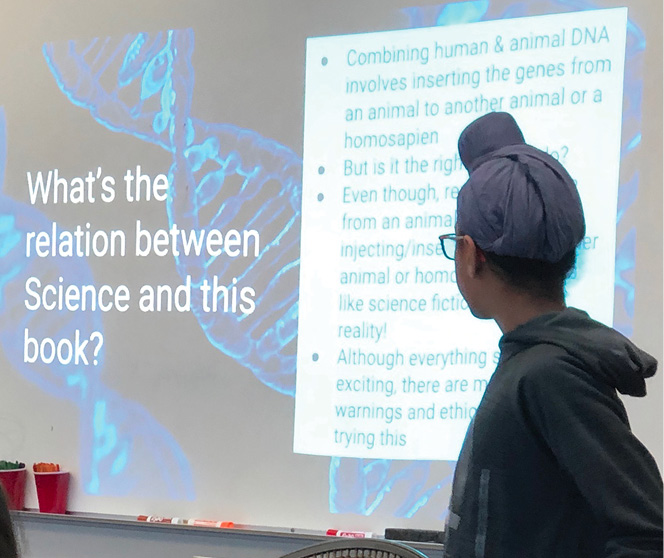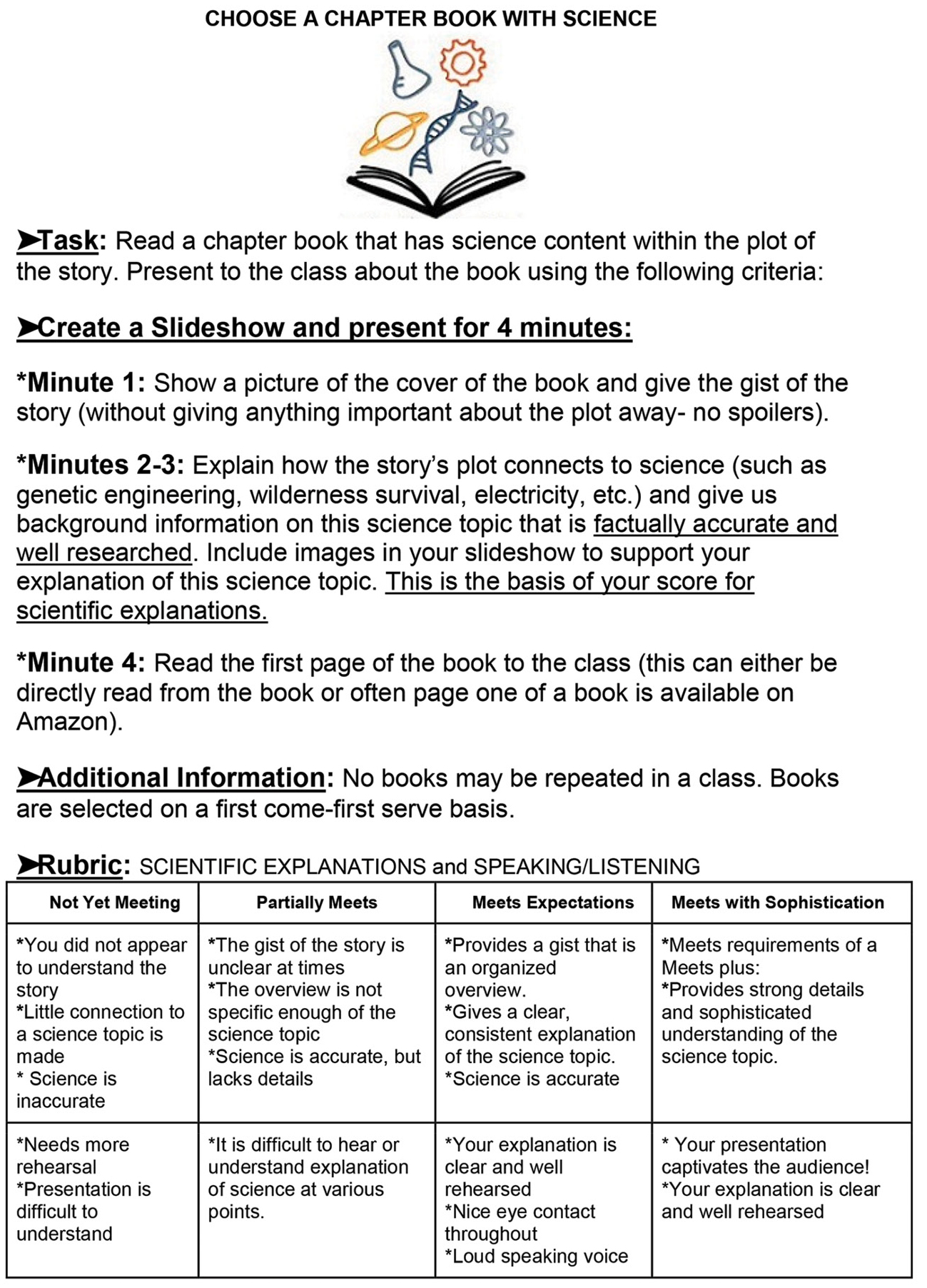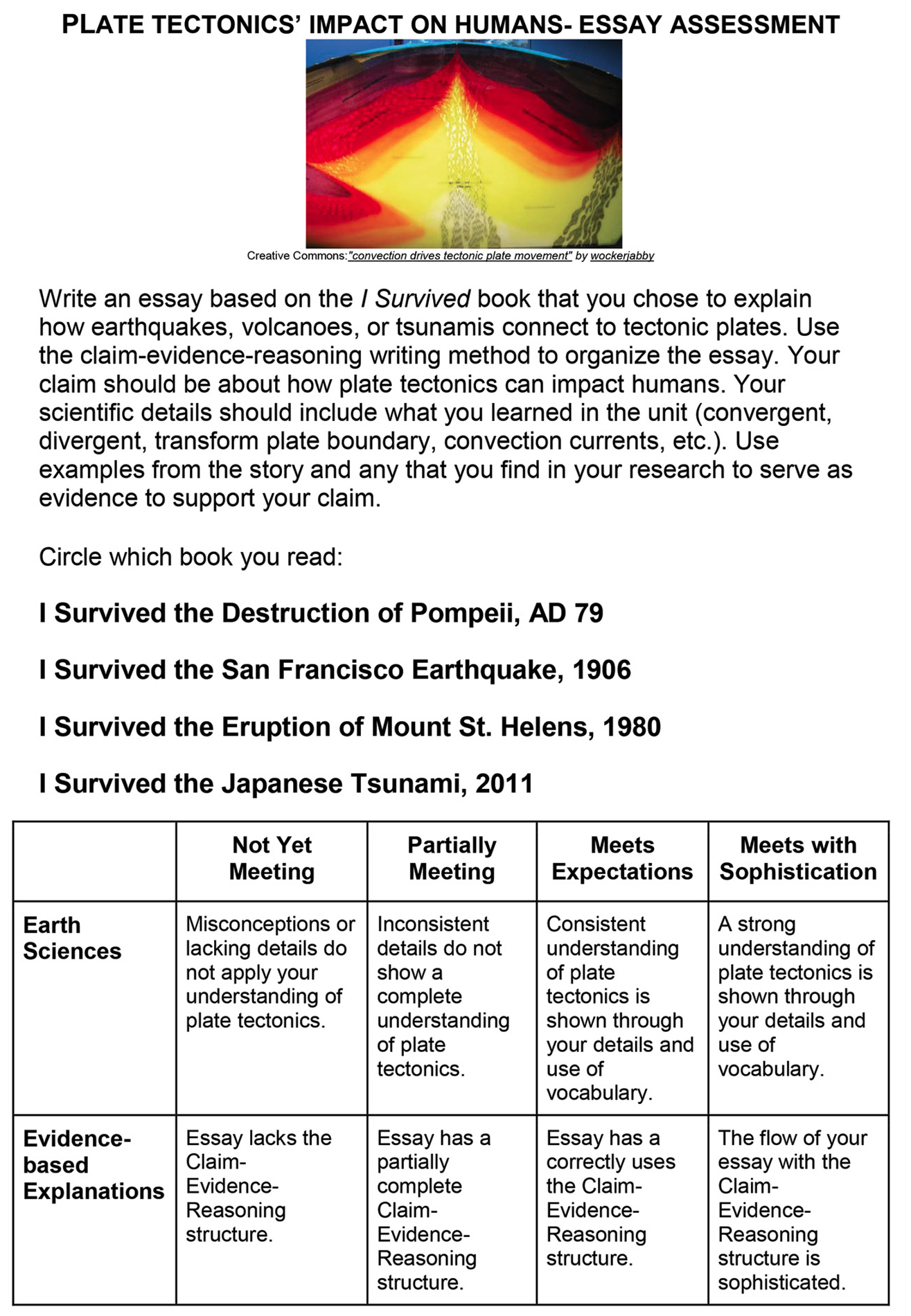interdisciplinary ideas
Using Science-Themed Fiction Chapter Books In The Classroom
Science Scope—March/April 2021 (Volume 44, Issue 4)
By Katie Coppens

A student’s science-themed book presentation on Spliced by Jon McGoran.
Fiction books can open the door to student curiosity about a range of science topics. Chung and Keckler’s (2016) research explored how well-chosen, science-themed books, which are used as part of a shared class experience, can benefit students’ scientific literacy. They emphasize the value of using science-themed books as a social, interactive model of instruction.
Book-based presentations
One strategy of integrating science-themed chapter books that I use with my students is having each student present on the science concept found in a science-themed fiction book. I conduct this activity early in the year to expose my students to a variety of science topics, encourage reading, and help me better get to know my students. In mid-September, I reach out to my school’s librarian and ask her to select a range of popular science-themed fiction books, such as The Big Dark, The Science of Breakable Things, and Storm Runners. I explain to my classes that each student will end up choosing a different book to read and present about one aspect of the science within the book. Once at the library, students have 15 minutes to look through and select a book to check out. We head back to class, and students start reading their book to make sure that they enjoy it and that the reading level is the right fit for them. During this time, I ask students to sign up for a day in October to present.
Prior to the presentations, I model a four-minute book presentation using Michal Vey: The Prisoner of Cell 25 (Michael Vey has electromagnetic powers, including the ability to control lighting). I first give the gist of the book, which is a quick summary of the book’s essential details. Next, I explain the concept of an electric current, then show an image of a cloud with positively and negatively charged particles to explain electrostatic discharge. This is followed by a slow-motion video of a lightning strike, which I use to explain the science behind why lightning strikes occur. I then read the first page of the book out loud (see Figure 1). This book is purposely chosen because it’s labeled a “high-low” book, meaning that it is both high interest and has a low-readability level—the Lexile level is 500 (Lexile Framework for Reading 2021), yet the main character is 14 years old.

Rubric for book presentation assignment.
My modeling helps clarify the assignment and my expectations for students. I explain that I could have chosen to do my presentation on genetic engineering or electricity, which are other science concepts in the book, but that I chose to focus on lightning. I emphasize that students can choose any science topic from their selected book.
The four-minute presentations become a part of our class routine during October and allow me to have a better sense of what topics interest my students, while introducing them to a variety of science concepts. An extra benefit is that students become excited about many of the books, often writing down book titles that they are interested in reading.
To support English language learners (ELLs) and developing readers, I have some books available on audio and include books with a range of Lexile levels (see Figure 2; see also Supplemental Materials for a list of other science-themed books). Lexile levels are based on sentence complexity and the difficulty of vocabulary. I also make sure that ELL students present toward the end of the month, which allows them more time to read and more opportunities to see a variety of student presentations. I encourage my ELL students to present in front of the ELL teacher and myself to help them be more comfortable before speaking in front of their peers.

Science-themed fiction books mentioned in this article, with a range of Lexile levels.
Book studies
Another way that I use science-themed chapter books in my classroom is to have a book study that applies to a science topic or unit. For example, during our study of plate tectonics, I use Lauren Tarshis’s book series called I Survived, which are fictionalized stories of true historic events with a different main character in each. Each book has a Lexile level of 610–700, which is a third- to fourth-grade reading level (see Online Resources for link to Lexile website). I purposefully choose books with a low Lexile because I’m not assessing my students’ ability to read, but instead their ability to connect science to the content of the book. The books are a little over 100 pages and are easily read by the majority of my students. Students read one of the following books: I Survived the Destruction of Pompeii, AD 79; I Survived the San Francisco Earthquake, 1906; I Survived the Eruption of Mount St. Helens, 1980; or I Survived the Japanese Tsunami, 2011.
Each student selects one book out of the four to read for their essay assessment and conduct background research on the event from websites I provide (see support websites in Supplemental Materials). I select sites that are reliable sources and do not contain graphic imagery, especially for recent events like the 2011 tsunamis. Students read the book to understand how plate tectonics can impact humans, taking between 45 and 90 minutes to complete their reading. I set aside one full class period for reading; any unfinished pages are read for homework. Recorded readings of the I Survived books are available on YouTube to support those who would benefit from them.
Prior to reading, I explain that students will be responsible for writing an essay over one class period that uses the claim-evidence-reasoning model to explain how the book demonstrates plate tectonics and how plate tectonics impacts humans. When writing the essay, students use their notes with background research from the websites as well as notes they took when reading the book as a reference. Students like knowing the essay topic ahead of time because it helps focus their reading. Figure 3 shows the essay assignment.

Essay assignment rubric.
Book studies can be incorporated into any science unit. For example, when teaching about genetics or genetic engineering, students can connect what they have learned to books like: Wake Up Missing, The Adoration of Jenna Fox, Spliced, Double Identity, The Angel Experiment: Maximum Ride, and Jurassic Park. Books that supplement an ecology studies include: Hoot, The Thing About Jellyfish, The Line Tender, Bees on the Roof, and A Circle of Elephants.
Other strategies
Cook and Dinkins’s (2015) research emphasized the importance of engaging students’ out-of-school interests in the classroom. One example they discuss is students’ fascination with topics like zombies in popular culture and embedding the science fiction book World War Z into a lesson. A book trailer, which is an online video preview of the book’s plot available on YouTube, and an excerpt from the book could serve as the hook for a lesson on topics like pathogens, viral outbreaks, or natural selection (see Online Resources for a link to the book trailer).
Science-themed book ideas can also be the impetus for collaboration with English teachers who may have strategies regarding science-themed books. For example, many English teachers take part in “First Chapter Friday” by reading the first chapter of a book one day a week to serve as a hook to help their students find books that they would enjoy reading (Moss 2019).
Throughout the various strategies of integrating science-themed chapter books into your classroom, the primary goal is student engagement, application of scientific thinking, and the integration of literacy. In addition, there is the added benefit that each of these assignments provides differentiation through the variety of book choices, thus serving as a celebration of students’ individual interests. •
Supplemental Materials
Support websites for I Survived books
Online Resources
Lexile Framework for Reading—https://lexile.com
World War Z book trailer—https://www.youtube.com/watch?v=Ty8xTNVMWrg
Katie Coppens (contactkatiecoppens@gmail.com) is a sixth-grade science and English teacher at Falmouth Middle School in Falmouth, Maine. She is the author of NSTA’s Creative Writing in Science: Activities that Inspire and various science-themed books for children including The Acadia Files chapter book series, Geology is a Piece of Cake, and What Do Black Holes Eat For Dinner? And Other Silly, Yet Totally Smart, Questions About Space.


